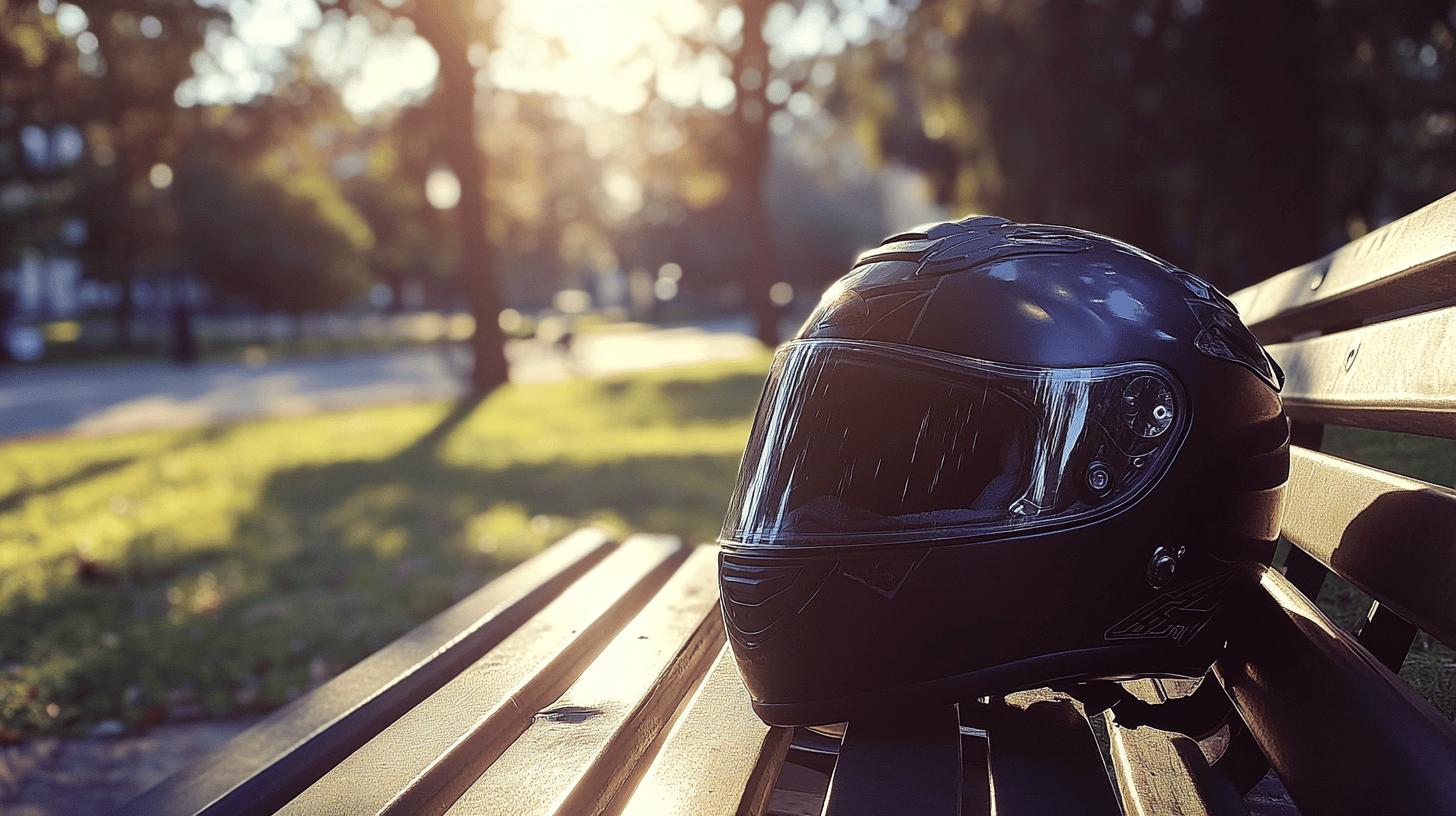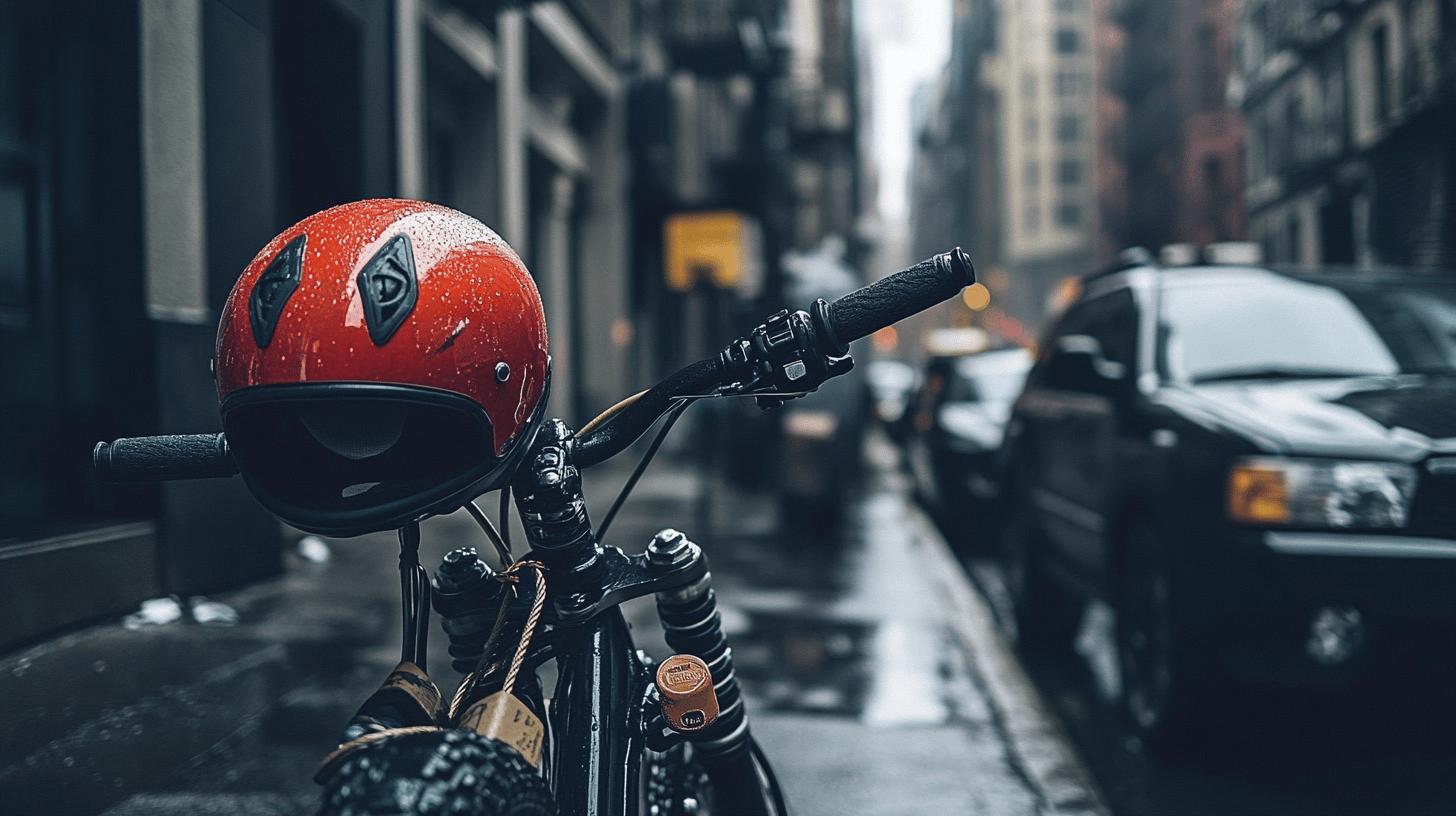Have you ever parked your motorcycle and returned to find your helmet missing? The growing prevalence of helmet thefts, especially during warmer months, highlights a pressing need for effective security measures.
Motorcyclists may instinctively shield other bike components, yet leave helmets exposed, increasing theft risks. By securing your helmet properly, not only do you safeguard your investment but also enhance your sense of safety and confidence on the road.
In this article, we'll explore essential strategies and tools for keeping your motorcycle helmet secure, ensuring peace of mind every ride.
Understanding Helmet Security: Why It's Crucial

Helmet theft is a common issue that riders face, especially during the warmer months when theft rates tend to spike. Leaving a helmet unsecured increases the likelihood of it being stolen, which can be a costly and inconvenient experience.
Motorcycle helmets are not only an investment in safety but also a valuable asset that should be protected. Ensuring that your helmet is secure when you leave your bike unattended is crucial to avoid unwanted surprises.
-
Loss of a significant financial investment
-
Inability to ride without a replacement
-
Time and resources spent on finding a new helmet
-
Increased risk of theft of other belongings
-
Potential damage to the motorcycle if thieves attempt to remove parts to access the helmet
Securing your helmet is particularly important in high-theft areas, where opportunistic thieves are more likely to target unattended items. Implementing effective security measures not only protects your helmet but also deters potential thieves from targeting your motorcycle in the first place.
By prioritizing helmet security, riders can enjoy peace of mind, knowing their gear is safe while they are away from their bikes.
Exploring Helmet Lock Options

Motorcycle helmets need secure fastening to the bike to prevent theft, and helmet locks offer various solutions for this purpose. Whether attaching to the seat, handlebars, or another part of the motorcycle, these locks come in multiple forms to suit different preferences and security needs. Popular options include bolt locks, carabiner locks, and cable locks, each with unique advantages.
Bolt Helmet Locks
Bolt helmet locks provide traditional keyed security, making them a reliable choice for many riders. These locks typically attach to fixed parts of the motorcycle, such as the frame or the seat, ensuring that the helmet is firmly secured.
Their design often makes them a permanent fixture on the bike, allowing for quick and easy helmet locking without the need for additional equipment. This type of lock is ideal for those who prefer a straightforward, effective security measure.
Carabiner Helmet Locks
Carabiner helmet locks utilize a combination lock mechanism, offering keyless convenience and adaptability. Inspired by climbing gear, these locks are made from heavy-duty metal and are versatile enough to secure helmets to various parts of the motorcycle.
Their flexibility allows riders to lock helmets in different configurations, accommodating various bike designs. This makes carabiner locks a popular choice for those seeking both security and ease of use.
Cable Helmet Locks
Cable helmet locks are known for their affordability and ease of use. Often featuring a steel cable threaded through a padlock, these locks can secure helmets and other accessories to the bike.
The length of the cable provides additional reach, making it possible to lock the helmet to more distant parts of the motorcycle. While they are among the most economical options, the quality of the cable is crucial, as thicker cables offer better protection against cutting attempts.
When selecting a helmet lock, it's important to read reviews and check ratings to ensure the product meets your security expectations. User feedback can provide valuable insights into the durability and effectiveness of different locks, helping you make an informed purchase.
Best Practices for Securing Your Helmet on a Motorcycle

- Select a High-Quality Lock
What type of lock is best for securing a helmet? A high-quality lock, such as a bolt or cable lock, is essential for securely fastening your helmet to the motorcycle. These locks are designed to resist cutting and tampering, offering reliable protection.
- Identify a Secure Location on Your Bike
Which parts of the motorcycle are most suitable for locking a helmet? The handlebars or mirrors provide convenient spots for helmet attachment, as they keep the helmet stable and out of the way.
- Thread the Lock Through the Helmet
How should the lock be threaded for maximum security? Ensure the lock passes through a sturdy part of the helmet, like the chinbar or D-ring, to prevent easy removal or damage.
- Attach the Lock to the Motorcycle Frame
Where should the lock be secured on the motorcycle for optimal protection? Fasten the lock to the motorcycle's frame or a solid part of the bike to ensure the helmet remains securely attached.
- Double-Check the Lock's Security
What final step ensures the helmet is properly secured? Verify that the lock is tightly fastened and cannot be easily removed. This final check minimizes the risk of theft.
Consistently following these steps ensures your helmet is secured efficiently every time you leave your motorcycle. Establishing a routine for locking your helmet not only offers peace of mind but also serves as a deterrent against potential thieves. Prioritizing helmet security as part of your regular riding habits helps safeguard this critical piece of safety equipment.
Innovative Solutions for Helmet Storage

Panniers and top boxes are among the most effective on-bike storage options for securing motorcycle helmets. How can these solutions protect your helmet? They offer a lockable and weather-resistant space, ensuring that helmets remain safe from theft and environmental elements.
Panniers are typically mounted on the sides of the motorcycle, while top boxes are positioned at the rear. Both options allow for convenient access and storage of helmets and other equipment, making them ideal for long-distance riders or those frequently on the road. These storage solutions integrate seamlessly with the bike's design, providing both functionality and safety.
At home, storing helmets can be both practical and stylish. What are some effective home storage solutions? Specialized hooks and shelves provide designated spaces for helmets, keeping them organized and safe from potential damage.
Wall-mounted hooks can display helmets as part of the room's décor while ensuring they are always within reach. Shelves can be used to store multiple helmets, preserving their shape and integrity. Investing in padded or specialized hooks prevents scratches and wear, maintaining the helmet's condition over time.
| Storage Type | Features |
|---|---|
| Panniers | Lockable, weather-resistant, side-mounted |
| Top Boxes | Lockable, rear-mounted, space-efficient |
| Specialized Hooks | Wall-mounted, stylish, prevents damage |
Some helmets come with their own carrying cases, offering additional protection when off the bike. How do these carrying cases benefit riders? They provide a snug fit, preventing movement and potential damage during transport.
These cases are particularly useful for riders who frequently travel with their helmets, as they offer a secure and portable storage solution. Whether flying, driving, or simply walking, helmet carrying cases ensure that your helmet remains protected, minimizing the risk of scratches or impacts.
Anti-Theft Devices to Protect Your Motorcycle Helmet

Securing your motorcycle helmet with anti-theft devices is crucial for preventing loss and ensuring peace of mind. Why are additional security measures important? They offer an extra layer of protection beyond basic locks, deterring thieves who might otherwise target unattended helmets.
With theft rates higher during warmer months, employing robust security devices becomes a necessity rather than an option for riders wanting to safeguard their gear.
- Cables and Alarms
What makes cables and alarms effective? They attach to the helmet and motorcycle, emitting a loud alarm if tampered with, effectively deterring potential thieves.
- U-Locks
Why are U-locks considered tough? Made from hardened steel, they resist cutting and tampering, providing a reliable method of securing helmets to the bike.
- Heavy-Duty Chain Locks
How do chain locks offer protection? Their robust construction and length allow for securing the helmet and other parts of the motorcycle, offering enhanced security.
- Bolt Helmet Locks
What is the advantage of bolt locks? These keyed locks attach to fixed parts of the bike, offering a permanent and secure place to lock your helmet.
- Carabiner Locks
What makes carabiner locks versatile? With a combination lock mechanism, they provide keyless security and can easily adapt to different locking configurations.
Integrating these anti-theft devices into a comprehensive helmet protection strategy ensures maximum security. How can riders effectively protect their helmets? Use a combination of devices tailored to specific needs and environments.
For instance, pairing a U-lock with a cable alarm increases deterrence and security, making it more challenging for thieves to succeed. Regularly assessing and updating security measures based on new products and technology helps maintain an effective defense against helmet theft. Prioritizing helmet protection not only secures your investment but also contributes to overall motorcycle safety.
Real-World Examples and User Testimonials

User testimonials provide invaluable insights into the effectiveness of helmet security practices and products. How do testimonials aid riders? By sharing real-world experiences, riders gain firsthand knowledge of which helmet locks and security measures truly withstand theft attempts.
Feedback from fellow enthusiasts often uncovers practical tips and potential flaws in products that might not be evident through specifications alone. This collective wisdom helps riders make informed decisions about securing their helmets.
Consider the experience of a rider who used a carabiner helmet lock while touring. What was the outcome? The rider found that the lock's combination mechanism offered quick access and reliable security, even in high-theft areas.
Despite initial skepticism about keyless locks, the rider's positive experience underscored the lock's effectiveness in deterring theft, leading to its recommendation among peers. Such stories highlight the importance of real-world testing and user satisfaction.
Why should riders explore user feedback before purchasing helmet security products? Researching testimonials and reviews exposes them to diverse experiences and solutions that might better suit their specific needs. Engaging with online forums and review sites allows riders to gauge product durability, ease of use, and overall reliability.
By considering community-driven insights, riders enhance their helmet protection strategy, ensuring they choose products that have been vetted by those with similar concerns and riding habits.
Final Words
Understanding how to keep your motorcycle helmet from being stolen begins with recognizing the risks and exploring effective security options. From choosing reliable locks to employing best practices for securing helmets, this guide offers practical solutions.
Consider investing in anti-theft devices and exploring innovative storage options to protect your helmet effectively. Discovering real-world insights through testimonials enhances your decision-making. Stay proactive in safeguarding your gear, ensuring peace of mind and a worry-free riding experience.
FAQ
What is a Motorcycle Helmet Lock?
A motorcycle helmet lock is a security device designed to attach a helmet directly to a motorcycle, using mechanisms like bolt locks, carabiner locks, or cable locks for theft prevention.
How do you lock a helmet strap?
To lock a helmet strap, loop the lock through the D-ring or buckle on the strap and secure it to the bike. Ensure it's tight and can’t be easily tampered with.
What are the best options for a motorcycle helmet lock?
The best options include bolt locks for keyed security, carabiner locks for versatility, and cable locks for affordability and flexibility. Choice depends on personal preference and security needs.
How can a motorcycle helmet be secured to a bike?
To secure a helmet to a bike, choose sturdy attachment points like handlebars or seats. Use a lock that passes through the helmet and bike frame, ensuring it's tightly secured to prevent theft.
How to lock a helmet to a scooter?
Use a cable or carabiner lock through the helmet's D-ring or buckle. Attach it to a fixed part of the scooter, ensuring the helmet can’t be removed without unlocking.
How to prevent motorcycle helmet theft?
Prevent helmet theft by using high-quality locks, securing helmet in visible areas, and choosing secure locations on the bike. Combining anti-theft devices like alarms or cables enhances security.
Is motorcycle helmet theft common?
Motorcycle helmet theft is relatively common, especially in areas with higher traffic and during warmer months, making securing your helmet crucial to preventing loss.
What does tapping your helmet on a motorcycle mean?
Tapping your helmet on a motorcycle typically signals other riders about a police presence ahead. It’s a common gesture among motorcyclists for alerting peers.

Ryan Thompson is a 35-year-old sport bike enthusiast known for his adventurous spirit. With years of weekend rides and exploring new roads, Ryan brings fresh insights and firsthand experience to ProtectiveGearz. His energetic approach and passion for the latest gear make him a trusted source for riders seeking up-to-date advice.



